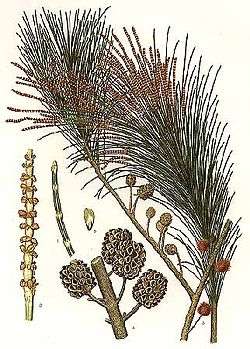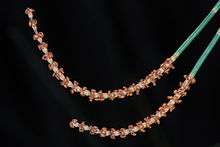Allocasuarina
Allocasuarina is a genus of trees in the flowering plant family Casuarinaceae. They are endemic to Australia, occurring primarily in the south. Like the closely related genus Casuarina, they are commonly called sheoaks or she-oaks.
| Allocasuarina | |
|---|---|
 | |
| Allocasuarina decaisneana in Central Australia | |
| Scientific classification | |
| Kingdom: | Plantae |
| Clade: | Tracheophytes |
| Clade: | Angiosperms |
| Clade: | Eudicots |
| Clade: | Rosids |
| Order: | Fagales |
| Family: | Casuarinaceae |
| Genus: | Allocasuarina L.A.S.Johnson[1][2] |
| Type species | |
| Allocasuarina torulosa (Aiton) L.A.S.Johnson[1] | |
| Species | |
|
61 species; see text. | |


Wilson and Johnson[3] distinguish the two very closely related genera, Casuarina and Allocasuarina on the basis of:
- Casuarina: the mature samaras being grey or yellow-brown, and dull; cone bracteoles thinly woody, prominent, extending well beyond cone body, with no dorsal protuberance;
- Allocasuarina: the mature samaras being red-brown to black, and shiny; cone bracteoles thickly woody and convex, mostly extending only slightly beyond cone body, and usually with a separate angular, divided or spiny dorsal protuberance.
Description
They are trees or shrubs that are notable for their long, segmented branchlets that function as leaves. Formally termed cladodes, these branchlets somewhat resemble pine needles, although sheoaks are flowering plants. The leaves are reduced to minute scales encircling each joint. Fallen cladodes form a dense, soft mat beneath sheoaks, preventing the development of undergrowth (a phenomenon known as allelopathy) and making sheoak woods remarkably quiet.
Another characteristic feature are the spiny "cones", about the size of an acorn but with a texture more resembling a conifer cone. However, sheoak "cones" are a woody fruit. Male specimens bear no fruit and are sometimes colloquially referred to as a "heoak".
As with legumes, sheoak roots possess nodules containing symbiotic nitrogen fixing bacteria; together with their highly drought-adapted foliage, this enables sheoaks to thrive in very poor soil and semi-arid areas. However, sheoaks are much less bushfire-tolerant than eucalypts.
Fossils of closely related species have been found dating back to the time of Gondwana.
Uses
The hard wood and rich texture makes sheoak wood popular among wood-turners. Sheoak wood is also regarded as an excellent firewood as it burns with very little ash.
Because of its ability to grow and develop extensive root systems in very poor or sandy soils, and to completely cover the ground with its "needles", it is often used to stabilise soils in erosion prone areas, or on sand dunes. Sheoak is also used as an ornamental shrub, although for this purpose the mat of "needles" may become a nuisance and must be carefully considered.
List of species
References
- Australian Plant Name Index (APNI): Allocasuarina IBIS database. Centre for Plant Biodiversity Research, Australian Government. Retrieved 3 November 2018.
- Johnson, L.A.S. (1982) Notes on Casuarinaceae II. Journal of the Adelaide Botanic Gardens 6(1): 73
- Wilson, K.L.; Johnson, L.A.S. (1989). "Flora of Australia online: Casuarinaceae". Data derived from Flora of Australia volume 3 (1989), a product of ABRS, ©Commonwealth of Australia. Retrieved 3 November 2018.
- Allocasuarina glareicola - endangered species listing Archived 2016-03-03 at the Wayback Machine Department of Environment & Conservation (NSW). Retrieved 2007-01-23.
- Allocasuarina littoralis www.organicmatters.com.au. Retrieved 2007-01-23.
- Allocasuarina portuensis Department of the Environment and Heritage. Retrieved 2007-01-23.
- Allocasuarina verticillata Windmill Outback Nursery, 2003-03-13. Retrieved 2007-01-23.
External links
| Wikimedia Commons has media related to Allocasuarina. |
| Wikispecies has information related to Allocasuarina |
- She-Oak Woodland & Forest (Tasmania Government)
- Research team from IRD working on Casuarinaceae